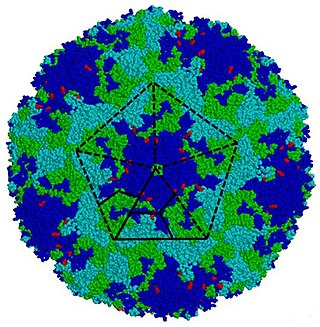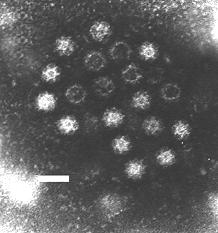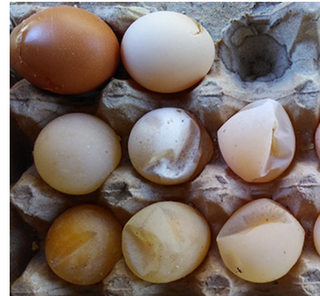
Picornaviruses are a group of related nonenveloped RNA viruses which infect vertebrates including fish, mammals, and birds. They are viruses that represent a large family of small, positive-sense, single-stranded RNA viruses with a 30 nm icosahedral capsid. The viruses in this family can cause a range of diseases including the common cold, poliomyelitis, meningitis, hepatitis, and paralysis.

Enterovirus is a genus of positive-sense single-stranded RNA viruses associated with several human and mammalian diseases. Enteroviruses are named by their transmission-route through the intestine.
Echovirus is a polyphyletic group of viruses associated with enteric disease in humans. The name is derived from "enteric cytopathic human orphan virus". These viruses were originally not associated with disease, but many have since been identified as disease-causing agents. The term "echovirus" was used in the scientific names of numerous species, but all echoviruses are now recognized as strains of various species, most of which are in the family Picornaviridae.

The Caliciviridae are a family of "small round structured" viruses, members of Class IV of the Baltimore scheme. Caliciviridae bear resemblance to enlarged picornavirus and was formerly a separate genus within the picornaviridae. They are positive-sense, single-stranded RNA which is not segmented. Thirteen species are placed in this family, divided among eleven genera. Diseases associated with this family include feline calicivirus, rabbit hemorrhagic disease virus, and Norwalk group of viruses (gastroenteritis). Caliciviruses naturally infect vertebrates, and have been found in a number of organisms such as humans, cattle, pigs, cats, chickens, reptiles, dolphins and amphibians. The caliciviruses have a simple construction and are not enveloped. The capsid appears hexagonal/spherical and has icosahedral symmetry with a diameter of 35–39 nm.

Orthohepevirus is a genus of viruses assigned to the family Hepeviridae. Orthohepevirus is a fairly isolated viral genus in which the virions are characterized by round, non-enveloped and isometric capsids with a diameter of 27–34 nm. The hepatitis E virus belongs this genus as the species Orthohepevirus A
Poultry diseases occur in poultry, which are domesticated birds kept for their meat, eggs or feathers. Poultry species include the chicken, turkey, duck, goose and ostrich.
Avian infectious bronchitis (IB) is an acute and highly contagious respiratory disease of chickens. The disease is caused by avian infectious bronchitis virus (IBV), a coronavirus, and characterized by respiratory signs including gasping, coughing, sneezing, tracheal rales, and nasal discharge. In young chickens, severe respiratory distress may occur. In layers, respiratory distress, nephritis, decrease in egg production, and loss of internal and external egg quality are reported.
Avian coronavirus is a species of virus from the genus Gammacoronavirus that infects birds; since 2018, all gammacoronaviruses which infect birds have been classified as this single species. The strain of avian coronavirus previously known as infectious bronchitis virus (IBV) is the only coronavirus that infects chickens. It causes avian infectious bronchitis, a highly infectious disease that affects the respiratory tract, gut, kidney and reproductive system. IBV affects the performance of both meat-producing and egg-producing chickens and is responsible for substantial economic loss within the poultry industry. The strain of avian coronavirus previously classified as Turkey coronavirus causes gastrointestinal disease in turkeys.
Marek's disease is a highly contagious viral neoplastic disease in chickens. It is named after József Marek, a Hungarian veterinarian who described it in 1907. Marek's disease is caused by an alphaherpesvirus known as "Marek's disease virus" (MDV) or Gallid alphaherpesvirus 2 (GaHV-2). The disease is characterized by the presence of T cell lymphoma as well as infiltration of nerves and organs by lymphocytes. Viruses related to MDV appear to be benign and can be used as vaccine strains to prevent Marek's disease. For example, the related herpesvirus found in turkeys (HVT), causes no apparent disease in the birds, and continues to be used as a vaccine strain for prevention of Marek's disease.
Aviadenoviruses are adenoviruses that affect birds—particularly chickens, ducks, geese, turkeys and pheasants. There are 15 species in this genus. Viruses in this genus cause specific disease syndromes such as Quail Bronchitis (QB), Egg Drop Syndrome (EDS), Haemorrhagic Enteritis (HE), Pheasant Marble Spleen Disease (MSD), and Inclusion Body Hepatitis (IBH). Avian adenoviruses have a worldwide distribution and it is common to find multiple species on a single farm. The most common serogroups are serogroup 1, 2 and 3.

Cardiovirus are a group of viruses within order Picornavirales, family Picornaviridae. Vertebrates serve as natural hosts for these viruses.
Teschovirus is a genus of viruses in the order Picornavirales, in the family Picornaviridae. Pigs serve as natural hosts. There are two species in this genus, including Teschovirus A, which is responsible for the porcine enteroviral encephalomyelitis disease caused in pigs. The genus name comes from this species and the disease it causes: Teschen disease, which itself was named for the town Teschen in Poland/Czechoslovakia where the disease was first recognised in 1929.
Avian orthoreovirus, also known as avian reovirus, is an orthoreovirus from the Reoviridae family. Infection causes arthritis and tenosynovitis in poultry. It can also cause respiratory disease.
Duck hepatitis is an acute and fatal disease in ducklings caused by the Avihepatovirus DHV-1 and DHV-3. It causes opisthotonus and hepatitis. DHV-1 is found worldwide. It causes disease in young ducklings, usually <6 weeks of age and spreads rapidly within a flock. It is the most virulent of the DHV species. DHV-3 has only been reported in the USA.
Blue eye disease is caused by La Piedad Michoacán Mexico virus (LPMV), the only member virus of the species Porcine orthorubulavirus in the Paramyxoviridae family. Synonyms for the disease include "Blue Eye Syndrome" and "Porcine Paramyxovirus Blue Eye Disease", and "La Piedad Michoacán Paramyxovirus Infection".
Acid-stable equine picornavirus (EqPV) is a member virus of Erbovirus A in the family Picornaviridae. They were isolated in the UK and Japan, from nasal swabs of horses with acute febrile respiratory disease.

Egg drop syndrome '76 is a viral disease that affects birds, notably chickens, ducks, geese and swans. It is characterised by a sudden drop in production of eggs as well as its eggshell quality in apparent healthy laying birds.

Avian metaavulavirus 2, formerly Avian paramyxovirus 2, is a species of virus belonging to the family Paramyxoviridae and genus Metaavulavirus. The virus is a negative strand RNA virus containing a monopartite genome. Avian metaavulavirus 2 is one of nine species belonging to the genus Metaavulavirus. The most common serotype of Avulavirinae is serotype 1, the cause of Newcastle disease (ND). Avian metaavulavirus 2 has been known to cause disease, specifically mild respiratory infections in domestic poultry, including turkeys and chickens, and has many economic effects on egg production and poultry industries. The virus was first isolated from a strain in Yucaipa, California in 1956. Since then, other isolates of the virus have been isolated worldwide.

Astroviridae is a family of non-enveloped ssRNA viruses that cause infections in different animals. The family name is derived from the Greek word astron ("star") referring to the star-like appearance of spikes projecting from the surface of these small unenveloped viruses. Astroviruses were initially identified in humans but have since been isolated from other mammals and birds. This family of viruses consists of two genera, Avastrovirus (AAstV) and Mamastrovirus (MAstV). Astroviruses most frequently cause infection of the gastrointestinal tract but in some animals they may result in encephalitis, hepatitis (avian) and nephritis (avian).

The history of coronaviruses is an account of the discovery of the diseases caused by coronaviruses and the diseases they cause. It starts with the first report of a new type of upper-respiratory tract disease among chickens in North Dakota, U.S., in 1931. The causative agent was identified as a virus in 1933. By 1936, the disease and the virus were recognised as unique from other viral disease. They became known as infectious bronchitis virus (IBV), but later officially renamed as Avian coronavirus.








